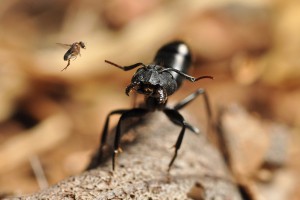 In this Q&A we discover how mere curiosity, and a spur of the moment shot, led to the first scientific study of a never before seen species interaction.
In this Q&A we discover how mere curiosity, and a spur of the moment shot, led to the first scientific study of a never before seen species interaction.
Bernardo Segura is this year’s BMC Ecology image competition Behaviour category winner. Near to completing a Masters in wildlife conservation in Chile, he has a head crammed full of potential research ideas and a desire to pursue wildlife documentaries about Chilean nature. Here we find out more about the passionate naturalist who loves just being out in a field to observe nature.
Tell us a bit more about this image?
“This photo is very special to me, because it represents the value of photography in scientific research and it also has some aesthetic value. To join photography with science and artistic beauty is something that I always try to achieve, usually unsuccessfully but the few successes make my day, month or even my year!”
What are the animals in it and what are they doing?
“It shows a Phorid fly trying to parasitize a Carpenter ant (Camponotus morosus) and it is the first ever record of a parasite for this ant species, even in this genus of ant in Chile.”
How did you become interested in photography?
“I got interested in photography as a way to show others my personal view towards nature. I feel that there is so much beauty in nature which goes unnoticed.
“You don’t have to be in a tropical rainforest to see stunning animals and the interactions between them. Natural spectacles are occurring all the time, even in the garden of your own home, you just have to pay attention.
“Photography has been a remarkable tool to me, allowing me to immortalize those precious moments in nature and share it to the world.”
What about the scene do you find particularly interesting?
“The ant, Camponotus morosus, has always intrigued me since I was a child. When I saw a group of 20 or so ants acting a bit strange; a group of soldier ants were standing still rather than racing about non-stop as they normally do; I immediately noticed it. I lay down to the ground to get a closer look.
“I saw the ants fighting to the death, cutting each other in half. Almost all the soldiers had some bit of leg or antennae missing and if you pay attention to the ant in the photo it too is missing part of its leg.
“I have never seen this in the wild, so I immediately started taking photos of this interesting observation. To my surprise, I saw a minuscule fly through the lens acting very strange. It always remained close to the ants, even landing on the ant’s head repeatedly. In some cases the ants were unable to remove the fly from their heads because their legs had been chopped by other ants.
“Once I started to investigate this interaction, I wrote to Brian Brown from the Los Angeles natural history museum. Brown was excited by the photos and told me that the phorid was a parasitic species that takes advantage of the ant’s fighting and encouraged me to write a publication of this observation.”
Where were you when you took this picture?
“I was on a field trip in central Chile, really close to Santiago, exploring an extraordinary forest called Altos de Cantillana. It was a naturalistic field trip of five days in the forest, only myself, my camera and tons of animals and interactions waiting to be captured on film.”
Why did you enter this image in the behaviour category, and how do you feel now you’ve won?
“This is not only a textbook example of species interaction, but it is an attractive photo in its own right and one that is visually interesting to anyone, not just scientists. It also documents an unknown interaction. It’s not just another lion hunting a zebra, it shows something that few people know about. It makes me happy that winning this prize will serve as a means to share this photo with many others.”
Comments